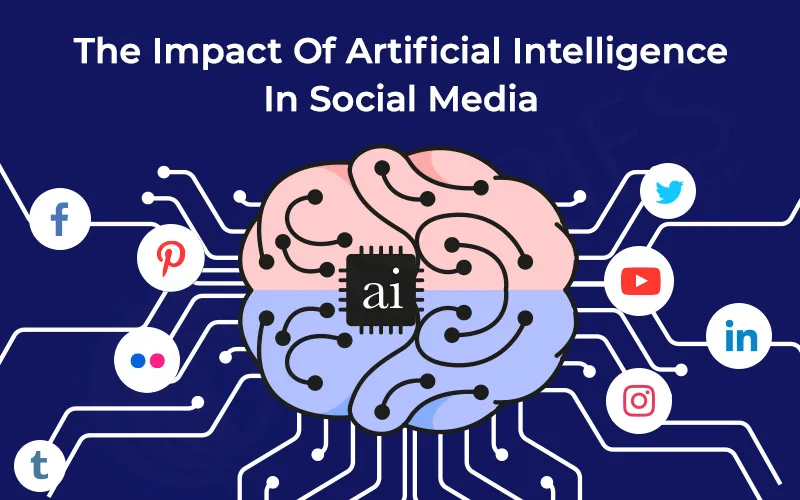

The Impact Of Artificial Intelligence On Social Media
Today, millennials need three things to survive – Music, Movies, and Social Media. Add another “M” for Machine Learning which is redefining the current business need. Artificial Intelligence and Machine Learning have joined together as two of the beckoning forces controlling the current era.

The way social media keeps rising to the occasion, the scenario is increasingly emitting all the Utopian vibes. In simple words, social media is aiming to deliver nearly perfect and desirable qualities to its people. However, it still has an uncanny resemblance to George Orwell’s dystopian world of 1984, where the “Newspeak” becomes the language of social media in terms of “Likes” and “Big Brother” becomes Artificial Intelligence itself – watching everything.
Statistics show that social media user base as of the year 2019 is estimated up to 2.77 billion. Artificial Intelligence needs to be properly applied, keeping the entire focus on the current business need. As social media users are growing at an unprecedented state, the business need is to efficiently process the unstructured data. And AI is providing solution to exactly that.
A study by McKinsey has highlighted that, in the year 2016, Machine Learning constituted around 60% of the total external investment of approximately $8 billion to $12 billion towards AI.
So, how does AI work in understanding the human behavior on the three most popular social networking sites – Twitter, Facebook and Instagram?
Artificial Intelligence in Facebook
The foundation on which Facebook builds its business is highly based on learning about the behavior of its user base. However, with over 2.38 billion users active per month sharing 4.75 billion content pieces daily – the data enthusiasts find it difficult to make sense out of such a large amount of unstructured data.
- Deep Learning (DL)
Deep Learning technique cometh to the rescue in this scenario which doesn’t need any specific data from an image. For example, there are a lot of dog images and videos that are shared across Facebook. Deep Learning has the ability to recognize the context of those videos and images. And, through that analysis it can also analyze what else are the contents of that media through meta and text. DL method produces insights which help in deciphering the frequency of appearances of products, simultaneously with these videos and images. This helps them placing ads for the people who might like to watch dog videos.
- DeepText
DeepText is a tool developed by Facebook team which helps in analyzing the words in the posts shared by users. The context of these words in relationship with the other words around it is analyzed by the neural networking to determine the underlying meaning. There isn’t any database which can be referred, instead it uses its own algorithm to learn these words. It helps Facebook analyze words across 20 different languages, because DeepText assigns certain labels to each word.
- Face Recognition
DeepFace is another technology used to recognize human faces in two or more than two different images. Facebook even claims that the tool has more accuracy than the humans themselves recognizing human faces – with 97% and 96% success rate, respectively. In fact, its way of putting names on their faces has also raised some controversies regarding the breach of the freedom to move around anonymously.
Artificial Intelligence in Twitter
Twitter is one of the most widespread social networking platforms with a user base of 328 million active users per month. Apart from instant messaging and micro-blogging, it has been monumental in event promotion, marketing, etc.
- Tweet Recommendations
Twitter uses AI while recommending the tweets on the user timeline. With 5,787 tweets every second as per the data of year 2014, the goal behind this is that users come across the most relevant tweets first. Previously, the tweets were highlighted in reverse chronological order. This has been facilitated by using Natural Language Processing (NLP), which helps in analyzing thousands of tweets per second. NLP provides insights on the preferences of users, so that they get to see only those tweets which they find interesting.
- Removing Hateful Accounts
There were many instances of accounts posting hateful and racist tweets. This led Twitter to use AI in identifying and removing those accounts using an algorithm. Such an algorithm is used to flag tweets which contain hate speech or promote extremist groups. Hence, 2017 saw the removal of almost 3 Lacs terrorist related accounts using AI-bots.
- Image Cropping Tools
Using AI inspired neural networking, Twitter aims to enhance the user experience. It helps in identifying and displaying only the most interesting part of an image to be used as a thumbnail in the tweets. Trimming tools are also designed in an engaging way. Apart from that, live videos are also monitored so that they can be arranged according to the topic – eventually enhancing their accessibility.
Artificial Intelligence in Instagram
Instagram has taken over social media like a thunderstorm as a social networking application in the year 2010. As of 2018, it claims of having a user base of around 1 billion. However, due to its increasing engagement rate, it has proven to be a great social marketing tool for brands too. 2016 indicated that around 98% of fashion brands have an account on Instagram.
- Discovering Experiences
The search function is highly dependent on the photos being uploaded on Instagram on a daily basis. With approximately 70 million photos uploaded on the platform every day, it creates a huge database by using hashtags, and trending information. AI helps users find images related to their favorite activities, experiences, events, eateries etc.
- Instagram’s Own AI Influencer
Miquela is the name of this AI influencer which is almost hard to believe that its “fake”. Just like any other influencer account, she has almost 1.6 million followers giving tips on fashion blogging. It's almost a human robot posting captions on photos, posing as a fashion model etc. In fact, she even collaborated with Prada in February 2018. Posting a 3D gif she also gave a virtual tour of her fashion space.
To Conclude..
AI and social media together, are proving to be highly beneficial for businesses. Development companies & marketing managers can utilize Artificial Intelligence services by studying user behaviors and searching habits for their customers. This would ultimately facilitate in reaching their target audience. Additionally, AI helps managers in tracking conversions efficiently – owing to a better marketing strategy and saving a huge amount of money.



![Top 10 Cheap Indian Press Release Distribution Services [Updated]](https://images.yourstory.com/cs/1/b3c72b9bab5e11e88691f70342131e20/LOGO-DESIGN-PR-INDIA-WIRE-03-1595693999405.png?mode=crop&crop=faces&ar=16%3A9&format=auto&w=1920&q=75)



